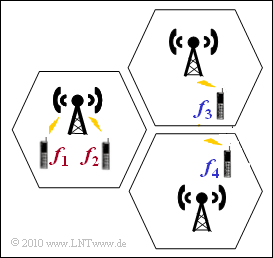Exercise 4.4: Cellular UMTS Architecture
In order to enable a nationwide network with low transmission power and sufficient frequency economy, radio cells are set up for UMTS - as for "GSM".
For simple system studies, hexagonal cells are assumed as shown in the diagram. In reality, the radio cells vary in size and are also adapted to the existing topology and infrastructure of the coverage area.
There are three different types of radio cells with a hierarchical structure:
- ${\rm Macrocells}$: 4 to 6 km in diameter, speeds up to 500 km/h allowed.
- ${\rm Microcells}$: 1 to 2 km in diameter, maximum speed allowed 120 km/h.
- ${\rm Picocell}$: diameter up to 100 m, many participants, extremely high data volume.
A macrocell can potentially overlay a large number of microcells and picocells. For a microcell, the maximum data rate is $384 \rm kbit/s$ for the maximum speed of $120 \rm km/h$. Subtask (1) deals with the maximum data rates allowed in a macrocell and a picocell.
In connection with the cellular structure of UMTS, terms are often used which will be explained in this task:
- intracell interference and intercell interference,
- cell breathing,
- handover.
Hints:
- This exercise belongs to the chapter "UMTS Network Architecture".
- Reference is made in particular to the pages "Access level architecture" und "Handover in UMTS".
Questions
Solution
(1) Only the last statement is correct:
- Since the range of radio signals decreases with increasing frequency at the same transmission power, the radio cells at UMTS (carrier frequency around $2 \ \rm GHz$) are significantly smaller than at GSM (in the D-network around $900 \ \rm MHz$).
- The maximum data rates for UMTS (which are more theoretical limits) are as follows for
- a macro cell up to $144 \ \rm kbit/s$,
- a picocell up to $2 \ \rm Mbit/s$.
(2) Correct are all statements:
- The two definitions for intracell and intercell interference are correct.
- Applying these to the scenario at hand (graph on the information page), we see.
- Intracell interference for $f_{1} = f_{2}$,
- Intercell interference for $f_{3} = f_{4}$.
- Intracell interference is more severe than Intercell interference because of the usually smaller distance of the interferers from the receiver, that is, it causes a smaller CIR (carrier-to-interference ratio).
(3) Correct statements 1 and 2 are:
- Cellular respiration is accurately described by the first two statements.
- With fewer participants now transmitting on a frequency, the negative influence of intracell interference is reduced.
- The participants in neighboring cells transmit on other frequencies and thus interfere much less.
- An alternative to cell breathing would be to maintain the cell size but reduce the transmit power of all participants within the cell, but this also means a reduction in the reception quality.
- The last proposed solution is simply wrong.
(4) Correct are all statements:
- For example, downlink data is split in the Radio Network Controller (RNC), broadcast over the participating "Node Bs", and reassembled in the mobile station.
- With soft handover, a mobile can communicate with up to three base stations simultaneously.
- This variant is of course superior to Hard Handover, but also involves greater effort.
